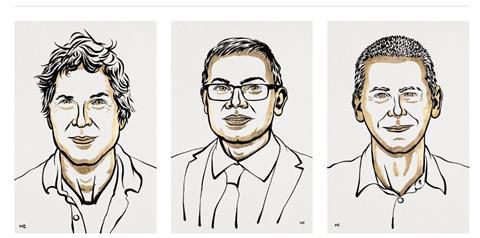
The Nobel Prize in Chemistry goes to the prediction of protein structure and folding.
‘Wonderful, isn’t it?’ says Utrecht protein expert Albert Heck. This year’s Nobel Prize in Physics went to the founders of AI, and the Nobel Prize in Chemistry to protein-related applications of AI. Half of that prize, that is, which was shared by Demis Hassabis and John Jumper of Google DeepMind. With their AI-based AlphaFold algorithm, they were able to predict the 3D shape into which an existing chain of amino acids will fold to form a protein.
The other half belongs to David Baker, who did the opposite at the University of Washington in Seattle. He spearheaded the Rosetta algorithm, which was found to be able to assemble proteins in any 3D shape from individual amino acids. ‘Protein design can make the world a better place’, he said at the Nobel Committee’s traditional press conference, which included a live phone call.
Rosetta was conceived in the late 1990s, when AI was still the stuff of the future. It had been known for decades, thanks to X-ray crystallography, that proteins by nature almost always fold into the same shape, which depends only on the amino acid sequence. It was also known that this shape determines the functionality of the protein. But it seemed impossible to predict it: as early as 1969, it had been calculated that a sequence of one hundred amino acids could theoretically fold in 1047 ways - good luck finding the right one.
A few fixed structural elements, however, turned out to recur in a very large number of proteins. So Baker based Rosetta on data from a large protein database, supplemented by calculations looking for the most favourable energy level of the sum of these elements. In 2003, he presented the first protein of his own design that behaved approximately as Rosetta had predicted.
Chess master
Predicting the folding of natural amino acid chains, which have a greater variety of odd twists than these solid elements, proved more difficult. In fact, for decades it was considered an unattainable holy grail in the life sciences. Until Demis Hassabis, chess master and co-founder of Google subsidiary DeepMind, developed a neural-network-based algorithm that he had trained on the same protein database. Called AlphaFold, it became world famous in 2018 for being the first to predict structures that actually exist. But it still made too many mistakes to be universally useful.
John Jumper, a newcomer to DeepMind who had a little more experience with proteins, then managed to improve the algorithm to the point where it was barely inferior to crystallography. The breakthrough came in the late 2020s, and since then AlphaFold2 has become an indispensable tool. Baker’s group was not to be outdone and has since launched a competing algorithm called RoseTTAfold - which, incidentally, did not win him the Nobel Prize. ‘It used to be called bioinformatics, now it’s called AI. You can’t get away from it’, says Heck.
He confirms that AlphaFold is a great tool that almost everyone in the research field is now gratefully using. But between the lines, he is even more appreciative of Baker’s work, which has led to completely new protein chemistry not yet found in nature. He himself, together with Baker, has an article in this field waiting for publication. ‘This research allows us to make things that are good for us.’












Nog geen opmerkingen